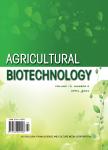Study on Tissue Culture of Japanese Honeysuckle ( Lonicera japonica )
作者机构:Huizhou Engineering Vocational CollegeHuizhou 516000China
出 版 物:《Agricultural Biotechnology》 (农业生物技术(英文版))
年 卷 期:2023年第12卷第5期
页 面:9-13,18页
学科分类:0710[理学-生物学] 07[理学] 071007[理学-遗传学]
基 金:Supported by Bureau of Science and Technology of Huizhou Municipality(2022CQ010025 2021SC040202004).
主 题:Lonicera japonica Explants Growth regulator Cytokinin
摘 要:[Objectives]This study was conducted to increase the reproduction coefficient of Japanese honeysuckle(Lonicera japonica)to keep the character of optimal benign.[Methods]The young leaves of medicinal Japanese honeysuckle were selected as explants,and MS was used as the basic culture medium.Suitable culture concentrations and conditions were screened through different concentration gradients of growth regulators and cytokinin.[Results]As the concentration of 6-BA in the culture medium increased,the browning rate increased,and the browning phenomenon occurred earlier.On the contrary,a lower concentration of 6-BA was suitable for the differentiation and growth of young leaves,and the browning response was slow.However,if the cultivation time was too long and the materials were not transferred in a timely manner,browning would also occur.The optimal combination of levels was obtained through a 3×3 orthogonal experiment(three parallel groups for each of 6-BA and NAA).The culture conditions included a constant temperature of 26℃and light intensity of 1200 lx.The optimal medium for inducing callus proliferation was MS+6-BA 0.5 mg/L+NAA 0.5 mg/L;and the optimal medium for inducing bud differentiation was MS+6-BA 1.0 mg/L+NAA 0.1 mg/L.[Conclusions]This study provides a theoretical basis for accelerating the development of the honeysuckle industry.



